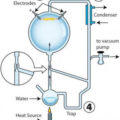
The mechanisms behind epigenetic inheritance (where changes in gene expression can be passed between generations without changes in the underlying DNA sequence of the organism) are becoming better understood thanks to scientists at Cold Spring Harbor Laboratory (CSHL). Reporting inCurrent Biology, CSHL professor Rob Martienssen explains that he and his team are studying the way DNA is packed in yeast, and how this packing can be transmitted across generations. The single-cell yeast organism is easy to study, in part because it lacks other epigenetic inheritance mechanisms, such as chemical modifications of DNA, that complicate the study of more complex animals and plants.
The dense packing of heterochromatin hides the DNA sequence from the cellular machinery that reads its genetic information, so the DNA in heterochromatin is “silenced.” The genes it contains are effectively turned off. But surprisingly, the clumping persists even after cells divide, although, says Martienssen, “it’s always been a mystery how modifications of histones could be inherited.”
A few years ago, however, his group and others solved this mystery. They found that histone modification is controlled by complicated cellular mechanisms broadly known as RNA interference, or RNAi. In RNAi, RNA that is copied from particular regions of DNA interacts with various proteins to modify histones in the same regions. Because the RNA matches only the section of DNA that produced it, it “provides the specificity that you need to make sure that only that part of the chromosome gets these histone modifications,” Martienssen explained. “If the whole chromosome were to get those histone modifications, you’d be dead.”
These results raised a new puzzle: Since genes contained within heterochromatin are silenced, how can they give rise to the RNA molecules that help to modify histones? Martienssen’s team has now solved this puzzle by tracking the cells through their cycle of growth and division. They found that the interfering RNA molecules appear only during the brief part of the cell cycle when DNA is replicating. This result, Martienssen says, “neatly accounts for the paradox about how ‘silent’ heterochromatin can be transcribed [into interfering RNA], because it’s transcribed only in a narrow window of the cell cycle.”
Related:
Read the paper
Epigenetic Changes Found In Schizophrenics
Fungicide Causing Unusual Epigenetic Changes In Rats
Inherited Disease Findings Stir Evolutionary Debate








Comments are closed.